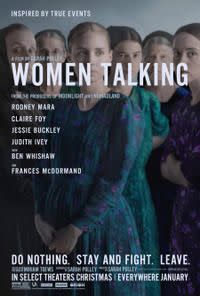‘Women Talking’ Proves Explicit Sexual Assault Scenes Are Entirely Unnecessary

"Hearst Magazines and Yahoo may earn commission or revenue on some items through the links below."
When I sat down for a screening of Women Talking, the new movie written and directed by Sarah Polley and based on the novel of the same name by Miriam Toews, I expected the intense—albeit important—subject matter to make it a tough watch. The movie follows a group of Mennonite women who have been sexually assaulted at the hands of the men in their community for years. A group of these women have been nominated to decide whether they should leave for a new, safer life.
A movie about sexual assault is not something I look forward to because normally such a movie comes with depictions of said assault, and violence against women is not something I file under "enjoyable to watch." Although sexual assault happens to people of all genders in real life, rape scenes in film and TV overwhelmingly feature women as the victims. Frankly, I'm over it! But Women Talking is a different story.

Women Talking (2022)
fandango.com
fandango.comThe movie blew me away because it manages to tell a whole story about the consequences of assault without actually showing any of the assaults taking place. I didn't have to cover my eyes through brutal rape scenes. I didn't have to see that look on an actor's face when they're doing their best to emote but you still feel gross watching. And I didn't have to think about what it was like on set filming something so explicit and sensitive. Women Talking is not actually a movie about assault, as I feared it would be. It's a movie about the aftermath of sexual violence, the person you become in the wake of it, and how you can protect the people around you from what you have experienced.
Polley was asked about the choice to bypass rape scenes at the premiere of the movie, and she said it was a very intentional decision on her part.
“I have rarely found that sexual assault captured on film has been additive or necessary to a film,” Polley told The Hollywood Reporter. “I felt there was probably not a way to do that without it being gratuitous and unnecessary, and given that that’s probably traumatic for some people to watch, you have to have a really good reason to show it. I just thought it was so much more important to talk about that moment after the assaults when there’s chaos in the brain, and the conversation that happens amongst these women about how to move away from the circumstances.”
Honestly, this shouldn't be a revolutionary take. But it is! Especially when you look at the amount of rape scenes we're still seeing on our screens. Just last year, Mike Barker's Luckiest Girl Alive starring Mila Kunis included three different rape scenes, taking up about three minutes of total screen time. Andrew Dominik's Blonde, the Marilyn Monroe biopic also released in 2022 starring Ana de Armas, depicts Marilyn's rape at the hands of a studio executive.
And although rape scenes have always existed in film, I started to notice a trend toward the extremely graphic a few years ago. For me, it started with the show 13 Reasons Why, which, sorry, was terrible. The first season (which included two different brutal rape scenes) was released in March 2017. This was when movements like #ItsOnUs were starting to pick up major steam, and #MeToo was mere months away. As women around the world were simply trying to get people to believe them, it seemed like the assault scenes on our screens were growing more and more violent. It was almost like someone thought the solution to making people believe assault existed IRL was to give audiences female-centered stories with vicious rape scenes. Like, Look how bad this is. See? Do you believe women now?
But does that really count as progress? Especially when it has the potential to re-traumatize survivors, as assault scenes do? And especially especially when it's actually coming from the perspective of a male writer or director, as it often does? Where does bringing awareness end and exploitation begin? I'd argue that the Venn diagram might just be a circle.
What Women Talking proves is that you don't need any of that. In fact, you can make a whole movie about rape and abuse without actually depicting the act itself. And an incredibly powerful movie, too! The lack of gratuitous violence in Women Talking was freeing because it allowed me to focus on literally everything else: the questions of forgiveness, religion, community, and survival, which is what the whole thing was really about. Not only did the movie not lose anything, but it gained the benefit of not distracting people. I hope the rest of Hollywood can recognize the power in that.
You Might Also Like


